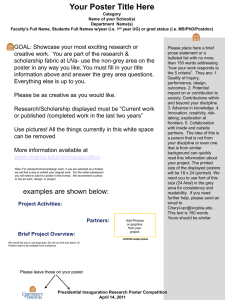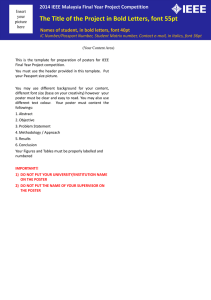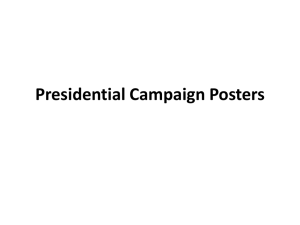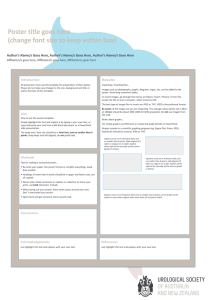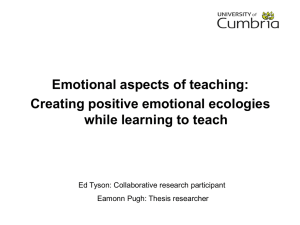guidelines and formats for posters
advertisement
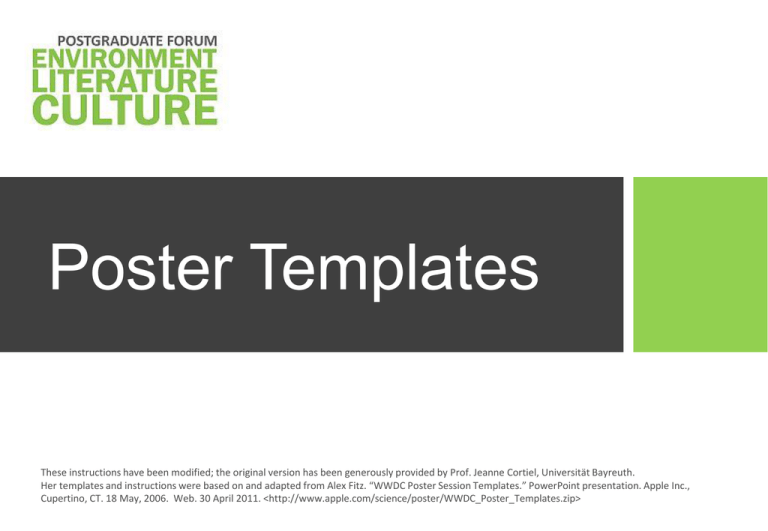
Poster Templates These instructions have been modified; the original version has been generously provided by Prof. Jeanne Cortiel, Universität Bayreuth. Her templates and instructions were based on and adapted from Alex Fitz. “WWDC Poster Session Templates.” PowerPoint presentation. Apple Inc., Cupertino, CT. 18 May, 2006. Web. 30 April 2011. <http://www.apple.com/science/poster/WWDC_Poster_Templates.zip> Format and Layout This PowerPoint file provides some information on how to create a poster to showcase your research. We compiled some recommendations on style, font size and column layout. These are only recommendations and you can of course mix-and-match in a way that best meets your aesthetic needs. You are in no way restricted to using the graphical elements as they appear in this file. Format The templates are designed for posters in landscape format (Querformat). The poster size is based on the standard A0 size, which is the largest paper format. A0 size = 118,9 cm x 84,1 cm (46,8 x 33,1 inches). The posters for the “Framing Nature” conference will be printed in size A1 ( = 841 x 594 mm)! Text To ensure readability, try not to include too much text on your poster. Around 800 -1000 words are ideal. Break the text into shorter paragraphs. Blank space on the poster should be at least 30%. Pictures Posters are a visual medium, so you should make use of relevant images and graphs. Make sure the pictures you use for your poster have a high enough resolution (200-300 dpi). Save your pictures as JPEG, PNG, TIFF or GIF- files. Be aware of copyright regulations when taking images from the internet. Recommended Font Size/ Font: Your poster should be readable from a distance, so you should choose font sizes between 28 and 60. Font sizes for the title can be up to 120. Font size for image captions and reference section should be 18 - 24. Sans-serif fonts are easiest to read and should be used for title and headings; serif-fonts can be used for longer text paragraphs. Preparing the document for printing Before submitting the document for printing, please convert the one slide that shows the final version of your poster into a pdf file and save a copy with a meaningful file name (such as: framingnature_poster_yourname.pdf). The please send it to framing_nature@semiootika.ee by March 25, 2014. Structure Your poster should include the following sections: Abstract A good abstract should include a short contextualization of your research, your main research question (which you should in some way highlight visually so it stands out), and your thesis (the answer to your research question in one or two sentenes). It shares many characteristics with an introduction to a term paper or an essay, but it should be more condensed and stand on its own (so you would not say things like “in this poster I will …”) Method In this section, you should briefly present the methods, concepts and theoretical approach(es) you used for your analysis. In other words, here you should define as precisely as possible how you answered the research question. Analysis In this section you are asked to present your analytical argument. Relevant images or quotations from your primary texts should be used selectively to illustrate and strengthen your argument. Conclusion What did you find out and what does it mean in the context of your research questions? Provide a short summary of your thesis and results. Discuss the relevance of your findings. References Bibliography of primary and secondary literature cited on the poster. Templates Title goes here Researcher / Presenter Name Affiliation / University Title Title Title Title Title References Framing Nature: Signs, Stories and Ecologies of Meaning, April 29 –May 3, 2014, Tartu, Estonia Title goes here Researcher / Presenter Name Affiliation/ University Title Title Title Title References . Framing Nature: Signs, Stories and Ecologies of Meaning, April 29 –May 3, 2014, Tartu, Estonia TITLE Researcher / Presenter Name Affiliation/ University Title Title Title Title Title Place Graphic Here Place Graphic Here Place Graphic Here Place Graphic Here Place Graphic Here Title Place Graphic Here Framing Nature: Signs, Stories and Ecologies of Meaning, April 29 –May 3, 2014, Tartu, Estonia Place Graphic Here


